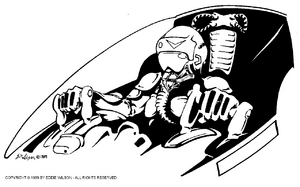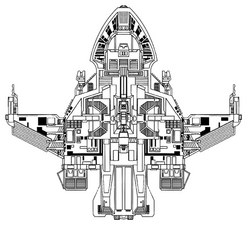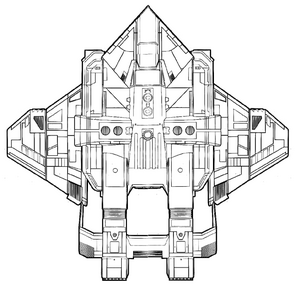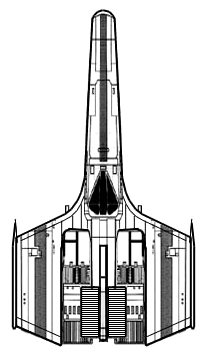Starflight: Starfighters in Alpha Dawn
From Star Frontiers Network
Top:Star Frontiersman main page | Up: Star Frontiersman Issue 5 main index | Up: New Rules main index
| This article has been specially edited by the author for Star Frontiers Network to include updates from the Stellar Errata of Starfrontiersman Issue #7 and the specially requested Hard Lock Missile and Mini-rockets. Other changes include the Weapon Modifications rule, step-by-step construction guidance and examples, and clarifications of definitions.
Remember, though this article focuses on fighters, these rules can also be used for normal vehicles. |
One of the most enjoyable sci-fi elements is when the heroes strap into small fighters and fly out to perform dangerous missions and combat. This aspect of the sci-fi hero seems to have been almost entirely overlooked in Star Frontiers—until now.
The uniqueness of different types of fighters and how they’re equipped is sadly missing from the game. The only thing differentiating them in Knight Hawks was whether they were civilian or military. Then articles came along that gave more weapons and defensive options, but still the variety was stale. In fact, in previous information we are counseled not to even use fighters. So what was the point in including them in the first place?
In order to make space fighters usable and more unique, one from the other, and to make space combat possible for these small vessels, fighter vs. fighter, we must look to the smaller combat scale of the Alpha Dawn vehicle rules system and analyze how fighters can be used.
For this system, the space fighters and shuttles have been reclassified as vehicles, instead of spaceships, as they are little more than cloud flyers with minor modifications for space travel. A fighter has very few gauges that can be found on most space ships.
Other treats in this article include more weapons available for fighters and aerospace vehicle system packages.
Though this article focuses on fighters, feel free to use this information to design your own aerospace vehicle. There’s even information here that can be used for ground vehicles.
The Knight Hawks rules prove particularly ineffective for space units of size 1 and 2. The smaller the craft, the less relevant the spaceship stats prove to be. As it is, they are just relevant enough for the Assault Scout, but for nothing smaller.
To remedy this, these vehicle rules are being extended in this article to units of hull size 2 or less. A whole different scale of damage applies that is not as extreme as large spaceship damage.
The vehicles, weapons, defenses, and equipment in this article are by no means exhaustive, but contain all the items this author feels worth use from previous articles and new creations. Most items from other materials are not included here, but are useable with this system.
| Frame Size (KH) | Mass in kg | Engine size |
| F1 (HS1) | <50 | Standard |
| F2 (HS1) | <100 | Standard |
| F3 (HS1) | <200 | Standard, A1* |
| F4 (HS1) | <500 | A1 |
| F5 (HS1) | <1000 | A1 |
| F6 (HS1) | <2000 | A1 |
| F7 (HS1) | <5000 | A1, A2* |
| F8 (HS1) | <10,000 | A1, A2* |
| F9 (HS2) | <20,000 | A2 |
| F10 (HS2) | <50,000 | A2 |
| F11 (HS2) | <100,000 | A2 |
| F12 (HS2) | <200,000 | A2 |
| * Single engine design only. | ||
Contents |
Fighter Construction
To start, choose the aerospace fighter type from the descriptions below, then look on the Available Fighters Table to determine the size ranges for that fighter type in the first column and write down the rest of the information on the row for that fighter. Then note the engine size available for your craft from the Engine Table and choose your engine type, noting the information on your record sheet. Work with your referee to determine the final value of variant numbers, including cost.
Aerospace Fighter Types
Besides the vehicles in the Alpha Dawn rules, more flying vehicles may now be available. These types are defined below. As you read them, enjoy the various fighter types that are graphically represented with each description.
Mini-flyers

| |||
| Pendulum | Lantern | Jaunt | Perilous |
Little more than an air-bubble with a ramjet engine attached, the mini-flyer is able to reach high altitude space stations from a planet’s surface, but does not have the capability to escape a planet’s gravity without breaking apart. Miniflyers cannot have any defenses and will only fit laser pods and mini-rockets. They can only hold a single passenger (the pilot) and have limited cargo capacity, such as for a tool kit and change of clothes. The low cost helps keep them viable, and surprisingly popular for personal transportation to and from orbital stations and high altitude launch platforms.
Personal Fighters

| |||
| Stylus | Hunter | Regent | Dijack |
Personal fighters are often better armed than Cloud Flyers, but can only carry up to 2 people. Personal fighters have no bombing capability or armor to speak of, but their teeth can be nasty. Able to carry small assignments of piston and pod weapons, assault rockets, or missiles, personal fighters are the vehicle of choice for the more discriminating adventurer. They cannot carry bombs. Careful, though, these aren’t meant for war. Pirates often take on such vehicles and their pilots for a split of the booty, as a private air force is invaluable to commandeering civilian ships. They also prove invaluable for defending civilian ships.
Military Fighters
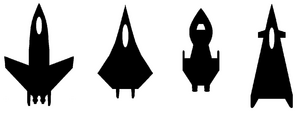
| |||
| Dark Hawk | Blade | Ripper | Black Dart |
You won’t find these for private sale, as they contain armor and advanced defenses for large scale skirmishes. Even black market traders know that private citizens can’t be trusted with these weapons of mass destruction. No, they want them sold to the highest bidder in the largest quantity. The military fighter is heavy duty in both fire power and defenses and are built with armor standard. Even though military fighters have limited bombing payload capacity, if any, military fighters are ten times more effective than personal fighters. These are often granted under special permission to Privateers, though common pirates tend to get a hold of them by raiding small military convoys.
Military Bombers
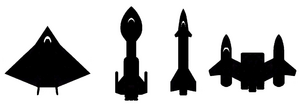
| |||
| Reaper | Trapper Arc | Clear Cutter | Massacre |
Often 2-4 times the size of most military fighters, military bombers carry many times more the payload of any fighter and are also armored. These are highly specialized killing machines capable of toppling large building complexes, flattening settlements, sinking sea carriers, and crippling or even destroying large space vessels when grouped with other bombers. Bombers all require a minimum of two crewmen (pilot and copilot/navigator) and are extraordinarily durable. (Bombers are technically Hull Size 2 from Knight Hawks rules)
Size
Though actual vehicle classes are often dependent on area, mass, and even shape altogether to determine size, to keep things simple, a new size rating (as opposed to the KH size system) is given for vehicle types relying on the vehicle’s base mass instead of its length. The frame sizes are listed as F1, F2, F3, F4, etc. The cargo weight and weapons do not affect the vehicle’s size, but the engines and computer systems do. The Vehicle Frame Size Table lists the frame sizes with compatible engine sizes. You can either have single engines or dual engines. "Standard" engines refer to small rich-mixture engines that can be either atmospheric ramjet, trans-atmospheric pion or space-only colloid thrusters (Chemical).
| Fighter Type* | Size (KH) | PN | ADF/MR | ADM | Cargo Limit | VSP | Cost** |
| Mini-flyer | 3 (1) | 1 | 6 | -1 | 400kg/4m3 | 10+d10 | >40,000Cr |
| Personal | 4-5 (1) | 1-2 | 6 | 0 | 8,000kg/12m3 | 20+d10 | >55,000Cr |
| Light Military | 6-7 (1) | 1-2 | 5 | +1 | 16,000kg/18m3 | 40+d10 | >65,000Cr |
| Heavy Military | 7-8 (1) | 2-4 | 5 | +1 | 22,000kg/26m3 | 45+d10 | >80,000Cr |
| Light Bomber | 8-9 (2) | 2-8 | 5 | +2 | 55,000kg/38m3 | 45+d10 | >105,000Cr |
| Heavy Bomber | 10-11 (2) | 2-12 | 5 | +2 | 100,000kg/50m3 | 50+d10 | >120,000Cr |
| * Ordered according to size | |||||||
| ** Costs are for empty structure only; it does not include equipment. | |||||||
New Engines
| Engines | Ramjet | Chemical | Plasma | After Burner |
| Size “A1” | ||||
| Fuel Cost | 20xFrame | 10xFrame | 10xFrame/2 | +10** |
| Prog. Level | 1 | 1 | 3 | 1 |
| Fnctn Pnts | 2 | 3 | 14 | 1 |
| Cost* | 8,000Cr | 20,000Cr | 55,000Cr | 5,000Cr |
| Size “A2” | ||||
| Fuel Cost | 40xFrame | 20xFrame | 10xFrame/4 | +20** |
| Prog. Level | 1 | 1 | 4 | 1 |
| Fnctn Pnts | 2 | 3 | 14 | 1 |
| Cost* | 15,000Cr | 30,000Cr | 100,000Cr | 10,000Cr |
| * Engine, installation and program costs per engine. | ||||
| ** Add this modifier to your fuel cost. | ||||
What is not generally known is that small craft of size 2 or smaller maneuver by means of colloid thrusters (a type of miniature electrostatic ion thruster) which are built into the frames. These work independently of the ship’s engines, though may derive their power from the engines. Because they are built into the aerospace vehicle, they are not a concern when choosing an engine for your craft.
Along with the new scale for fighters are new engine classifications. Engine size A1 is for Knight Hawks hull size 1, and engine size A2 is for Knight Hawks hull size 2 (See the Vehicle Size Table above for fighter size assignments).
Ramjet Engine. These are not as efficient as other engines and are useless for space flight because of their need for air flow. Though they are less expensive to purchase and install, they are more expensive to maintain and keep fueled (they use much more fuel than other engines and require more maintenance).
Plasma Drive. In addition to rocket boosters and atomic engines, there is also the more expensive plasma drive. A plasma drive is considerably safer, more compact, and easier to find, but much more expensive than an atomic drive. Plasma power is achieved by pulling radiant atoms apart through ionization instead of colliding them. Additionally, plasma drives have virtually 0 radiation emissions. They are the most efficient for inner-system travel. These can be sized to fit on any size of craft.
These are the small thrusters you see on many of your favorite space fighters. They are low maintenance, highly efficient, and ideal for relatively comfortable high speed launches, as their thrust requires building, easing into the launch speed. Their big brothers that we’ve come to know simply as Ion Drives, use particle acceleration which can cause a craft to approach the speed of light.
After Burner. This injects fuel directly into the ignited exhaust (“after” the engine), causing the vehicle to increase its acceleration beyond its standard acceleration. This can be useful for escaping an enemy, catching up to an enemy, or getting that extra burst for escaping atmosphere. However, this is an extremely inefficient expenditure of fuel, so use it wisely. This is available for any engine planet-side or in space.
Weapons
Now that you have your new fighter, choose your weapons, if any. While keeping the restrictions of the Armament table in mind, choose your fighter's weapons from the Weapons Table, recording their stats on your fighter's vehicle record sheet. Reference the Missiles Table and the Weapons Chance to Hit Table for combat.
New Weapons
Normal weapons have been thoroughly covered in other articles, so we will only discuss new weapons for aerospace vehicles here.
Previous board game and miniatures rules only provided assault rockets to fighters, and mounted laser pods were provided in the Polyhedron #19 article, Laser Pod, by John Pickens and laser pistons, maxi-missiles and fusion bombs were provided in the Dragon Magazine, November 1986, article, An Interstellar Armory by Gus Monter. Now prepare yourself for several new additions.
All weapons listed in the Armament Table are considered externally attached, except for bombs and starbursts, and has no bearing on space. A fighter can carry all the weapons listed on its row at the same time. Meaning that a Light Military Fighter of F7 can carry 8 missiles, 4 bombs, 4 starbursts, 1 Assault Rocket, and any one of the four beam or P.G.S. weapons. Of course this all depends upon the fighter's design and Referee's allowance. The discrepancy between the qualifying frame size of the Dual Piston and Bolt Launcher of the Armament Table and the Minimum Vehicle Size of the same weapons on the Weapons Table are due to that the Weapons Table shows what they can be attached to, but may require penalties (Referee's discretion).
| Fighter | Missiles | Bombs | Starbursts | Assault Rockets | Laser Pod | Laser Piston | Dual Piston | Bolt Launcher |
| Mini-flyer | 0 (8*)** | 0 | 0 | 0 | X | |||
| Personal | 2-6** | (2)** | 1-2 | 0 | X | X | V Size 5 | |
| Light Military | 2-8 | 2-4 | 1-4 | 1 | X | X | V Size 7 | X |
| Heavy Military | 2-12 | 2-8 | 1-8 | 2 | X | X | X | X |
| Light Bomber | 2-14 | 1-15 | 1-12 | 3 | X | X | X | X |
| Heavy Bomber | 4-20 | 1-30 | 1-12 | 5 | X | X | X | X |
| * Mini-flyers can load up to 8 mini-rockets. | ||||||||
| ** Though not legally permitted for civilian vehicles, personal fighters may still be adapted to arm these weapons. | ||||||||
| Weapon | MVS (MHS) | PL | FP | HDR* | HDR Mod* | RA (KH) | DTM | Restrictions | Mass | Ctr Avail | Cost** |
| Laser Piston (LP) | 1 (1) | 1 | 3 | 5d10 | 0 | 6 | 0 | FF, RD, MPO | 80kg | I, II, III | 1,500Cr |
| Dual Piston (DP) | 6 (1) | 2 | 6 | 5d10 | +10 | 6 | 0 | FF, RD, MPO | 110kg | I, II | 2,500Cr |
| Bolt Launcher (BL) | 4 (1) | 2 | 5 | 4d10 | +20 | 5 | +10 | FF, RD, MPO, LTD | 140kg (100kg) | I | 3,000 Cr (3,000 Cr/2,000ct) |
| Plasma Bomb (PlB) | 7 (1) | 1 | 2 | 4d100 | +50 | 0 | -20 | MPO, LTD | 1,000kg | I | 10,000Cr |
| Bomb Launcher | 7 (1) | 2 | 4 | -- | +10 | 0 | +5 | 800kg | I | 5,000Cr | |
| Mini-rockets | 2 (1) | 0 | 0 | 5d10 | +20 | 5 | -10 | FF, MPO, LTD | 10kg | I | 150Cr |
| Redeye Missile | 4 (1) | 2 | 3 | 1d100 | +30 | 6 | *** | FF, MPO, LTD | 100kg | I | 1,500Cr |
| Guided Missile | 4 (1) | 2 | 3 | 1d100 | +80 | 6 | -20 | FF, MPO, LTD | 100kg | I, II | 2,500Cr |
| Hard Lock Missile | 6 (1) | 2 | 5 | 1d100 | +70 | 6 | -20 | FF, MPO, LTD | 130kg | I, II | 5,000Cr |
| Starburst | 4 (1) | 2 | 3 | -- | 6 | -- | -- | vol: 1m3 | II | 1,000Cr | |
| * For Knight Hawks, divide all damage by 10 and round down. | |||||||||||
| ** Costs include installation | |||||||||||
| *** Automatic drive damage if hit: -ADF=damage/10 (round up). | |||||||||||
Bomb Launcher. A bomb launcher isn’t so much a weapon
as a delivery device. This vibration-resistant box attaches to a
cargo bay and stores any number of bombs on an antivibration
temperature control rack that delivers the bombs to
a box that accelerates the bomb through a hole with
minimum vibration and maximizes accuracy.
The bomb launcher is ideal for the very volatile Fusion bomb, giving the bomb 200% of its usual carrying distance and stability. It adusts to any cargo bay for F7 to Knight Hawks “Hull Size” size 3.
Dual-action Piston. This works similarly to the normal laser piston, but uses the rebound of two juxtaposed pistons and barrels to produce twice the fire rate and require less energy. However, these are heavier and may only be equipped to craft of F5 or more.
Proton Bolt and Launcher. This is a new and much more effective delivery system than the standard proton weapon. The Bolt Launcher is a recoilless weapon that uses large “smart” bullets designed for launching in space and other hostile environments. These “smart” bullets are programmed to ionize the protons of tri-carbon-incased hydrogen, producing a solid and relatively long-lasting proton bolt. Though recoilless, it is not free from vibration.
The Bolt Launcher can be attached to a personal fighter, but the mounting points must be serviced at a quarter of the cost after every use, as the vibrations could rip it from its mount after prolonged use. If the weapon itself is not serviced immediately after battle, it could lead to serious and even deadly consequences in later battles because of the discharge elements. It works against Albedo Screens and half capacity against Inertia Screens.
Plasma Bomb. Also called a “mini-nuke”, the plasma bomb causes a limited fission explosion with limited radioactive effects. Though not free from dangerous levels of radiation, it only irradiates a 1 cubic mile radius. If detonated on a planet, the radiation may be blown up to 100 miles.
Missiles. There are several types of missiles available to aerospace vehicles of all sizes. Destroying missiles before they reach their targets isn’t easy, but can be done, so they are provided with structural points. Missiles work in conjunction with your ship’s targeting system. The Missile Table is needed to help you know how fast you need to be traveling to get out of the way of the missile.
| Weapon Type | ADF | FP |
| Mini-rocket | 4 | 3 |
| Redeye Missile | 5 | 25 |
| Guided Missile | 5 | 25 |
| Hard Lock Missile | 6 | 30 |
- Mini-rockets are much smaller than normal missiles and have none of the programming, used primarily for spray and pray firing. You may fire 8 of these at the same time, following rocket battery rules. For every missile your ship can load, you can load 3 mini-rockets.
- Redeye missiles have infrared sensors that track a target’s heat trail.
- Guided missiles are guided by the onboard computer that has locked onto a target (must have Target Tracker or better).
- Hard Lock missiles have both infrared and guided capabilities along with "last known position" capability. They are slightly larger than other missiles. (-1 to the maximum number of missiles allotted to the fighter in the Armament Table for every 1-3 Hard Lock missiles added.)
| Weapons | None | RH | PS | ES | SS | MS | LAP | HAP | ICM | SB |
| Laser Piston (LP) | 65 | 40 | 65 | 65 | 65 | 20 | -- | -15 | -- | -- |
| Dual Piston (DP) | 65 | 40 | 65 | 65 | 65 | 20 | -- | -15 | -- | -- |
| Bolt Launcher (BL) | 50 | 50 | 25 | 60 | 30 | 40 | -5 | -10 | -- | -- |
| Plasma Bomb (PlB) | 70 | 70 | 70 | 70 | 80 | 70 | -- | -- | -- | -- |
| Mines | 60 | 60 | 60 | 60 | 60 | 60 | -15 | -20 | -5 | -3 |
| Torpedoes | 50 | 50 | 50 | 50 | 75 | 50 | -15 | -20 | -10 | -7 |
| Assault Rocket | 40 | 40 | 40 | 40 | 40 | 40 | -- | -- | -5 | -3 |
| Rocket Battery | 30 | 40 | 30 | 40 | 40 | 40 | -15 | -20 | -3 | -1 |
| Maxi-missile | 50 | 50 | 50 | 50 | 70 | 50 | -- | -10 | -10 | -4 |
| Seeker Missile | 75 | 75 | 75 | 75 | 75 | 75 | -- | -15 | -8 | -12 |
| Redeye Missile | 60 | 60 | 60 | 65 | 60 | 40 | -- | -- | -15 | -30 |
| Guided Missile | 75 | 75 | 75 | 50 | 75 | 75 | -- | -15 | -8 | -20 |
| Hard Lock Missile | 80 | 80 | 80 | 70 | 75 | 80 | -- | -- | -8 | -- |
| Abbreviations: Reflective Hull (RH), Proton Screen (PS), Electron Screen (ES), Stasis Screen (SS), Masking Screen (MS), Light Armor Plating Chance Modifier (LAP), Heavy Armor Plating Chance Modifier (HAP), Interceptor Missile Chance Modifier (ICM), Starburst Chance Modifier (SB) | ||||||||||
Note: I recommend Larry Moore's article, Non-Civilian Duty Vehicles, in Issue #15 of the Star Frontiersman for weapon modifications rules. Each weapon type listed on the Armaments Table is counted as one or more hard points. The Weapon Mounts Table provides the statistics concurrent with that article. The mini-rockets in this article count as small rockets. The sizes in the article Non-Civilian Duty Vehicles compare close enough to the sizes in this article that you may use the sizes in this article to calculate vehicle defenses and other calculations shown in that article. However, it is recommended that Vehicle Structure Points be calculated according to this article. | ||||||||||||||||||||||||||||||||||||||||||||
Equipment
Now that you have designed your fighter and chosen the weapons, choose the equipment to maximize its potential. Now that you have your weapons, you need defenses to survive the battle. However, don't choose your targeting system just yet. You have a chance to choose a special System Package that includes a weapons package, as well as the computer and other equipment at a reduced cost.
Defenses
Starburst. A decoy that emits ionized plasma and radio and electrical signals that radiates bright light and heat and confuses infrared and guided systems. Each time the vehicle is re-equipped with starbursts, the delivery system must be replaced. This makes starbursts a little more expensive, but also safer. These are similar to interceptor missiles in purpose, but are incapable of guided intercept and are very much smaller. You will find starburst stats on the weapons tables in this article.
Targeting Systems
Special targeting systems are used for aerospace fighters. These systems range from simple to very complex.
| Targeting System | Combat Modifier |
| Crosshair | +5 |
| Target Tracker | +10 |
| Multi-target Tracker | +15 |
| Target Discriminator | +20 |
Crosshair Targeting. A simple targeting system that provides a crosshair and on screen target measurement and locator. +5 to Hit. Crosshair targeting does not work with Guided Missiles.
Target Tracker. Provides all the abilities of the Crosshair Targeting, but provides a lock on without visual to the nearest target with a bias toward on screen targets. An inherent flaw exists in this technology in which if the pilot is chasing a target, another target that passes closer can distract the target tracker and cause you to lose your primary target. +10 to Hit.
Multi-target Tracker. Providing the abilities of the Target tracker, this system identifies all targets within a specific range and provides ranges for each target. Whichever target is within striking range gets a circle identifying it for attack. +15 to Hit.
Target Discriminator. Along with the abilities of the Multitarget Tracker, this targeting system not only chooses the best target and gives it a unique box, but is able to penetrate most forms of interference. +20 to Hit.
System Packages
In the list of new equipment are packages of communications, defense, and weapons programs with computer systems. These are packaged together to reduce costs and keep aerospace vehicle design simple. Any system can be used on any size aerospace unit that can fit the mass and volume, but you must pay the full price even for systems you do not use (ie., mini-flyers have no need for astrogation equipment).
| System Package | Prog. Level | FP | Mass (kg) | Volume | Cost* |
| I | 2 | 5 | 300-800 kg | 3-8 m3 | 9,000 Cr |
| II | 3 | 20 | 600-1,500 kg | 6-15 m3 | 28,000Cr |
| III | 4 | 40 | 1,500-2,400 kg | 15-24 m3 | 86,000Cr |
| IV | 5 | 64 | 2,900-3,800 kg | 29-38 m3 | 200,000Cr |
| V | 6 | 112 | 2,900-3,800 kg | 29-38 m3 | 270,000Cr |
| * Costs include installation. | |||||
System Package I. Ideal for keeping costs low, but is also low on amenities. Computer level 2. Contains: astrogation; crosshair targeting; videocom radio; computer lockout; life support; and parabattery.
System Package II. Often ideal for the standard personal fighter. Computer level 3. Contains: astrogation; target tracker; videocom radio; videocom screen (adjust cost for each screen according to Knight Hawks); computer lockout; damage control; life support; and parabattery.
System Package III. The most common military fighter control. Computer level 4. Contains: astrogation; multitarget tracker; subspace radio; videocom screen (adjust cost for each screen according to Knight Hawks); half-size camera system; skin sensors; security alarm; computer lockout; damage control; life support; and parabattery.
System Package IV. The most common military bomber configuration. Computer level 5 Contains: astrogation; target discriminator; subspace radio; videocom screen; half-size camera system; skin sensors; radar; security alarm; white noise broadcast; computer lockout; damage control; life support; and parabattery.
System Package V. Most often reserved for large military bombers and dignitary vessels. Computer level 6. Contains: astrogation; target discriminator; subspace radio; videocom screen; half-size camera system; skin sensors; radar; energy sensor; white noise broadcast; security alarm; computer lockout; damage control; life support; and parabattery.
Using Fighters
With having only been counseled against the use of fighters in the past, the understanding of how to use fighters is sadly undeveloped, so let us examine what uses fighters may have in Star Frontiers gaming.
Useful Tactics
Planetary Patrols. Large space-fairing vessels cannot enter a planet’s atmosphere, but smaller vessels can. As a result, fighters are the weapon of choice for planet-side defense and ground and air battles. Fighters are also ideal as escorts for vessels of Knight Hawk Hull Size 4 or smaller. They can provide effective defense against pirates and other undesirables.
Bombing Runs. Probably the most important use of any fighter in war time. While bombers are, of course, used to bomb ships and installations, small fighters can help protect bombers and can even provide cover and confusion so that bombers are hard to pick out of a swarm.
Skirmishes. Swarms of fighters are an effective way of overwhelming an opponent’s defenses. A squadron of fighters can often provide as much fire power as any Assault Scout. Imagine the power of a swarm.
Location Hopping. Simply going from location to location, players may want to have their own transportation to go from one part of a planet to another. This also opens up potential broader planet-side adventure ideas. Going from location to location, characters can be reassured in having the firepower for their defense.
Reconnaissance. Being able to scout a wide area is problematic without personal flight transportation, and is therefore resolved with the use of fighters and shuttles.
Quick Escape. Ever felt trapped by your surroundings? Having a fighter on hand can help provide players with that badly needed means of escape. Such escapes themselves can provide very unique opportunities at role-playing as characters try to creatively make their way back to their vehicle.
Damage
You can use these fighter rules to battle other fighters even in a game of Knight Hawks, but against the larger ships that have greater weapons, use the Knight Hawks weapons scale.
Alpha Dawn uses Structure Points (SP) or current STA, Knight Hawks uses Hull Points (HP), but these rules use Frame Points (FP). The frame points of your fighter are figured a little differently than in Knight Hawks. In these rules, FP determines damage resistance on the Fighter Type table. To interact with character weapons and defenses, multiply all fighter figures times 10. To interact with Knight Hawks weapons and defenses, including calculated HP, divide all fighter figures by 10 and round up.
DCR is calculated using the same formula in Knight Hawks, but using the frame size rules in this article. You will still use the Advanced Game Damage Table from Knight Hawks to determine the type of damage. Do not access the table if damage is from a character weapon, unless critical damage is rolled. When attacked by a ship using Knight Hawks rules, multiply damage and damage modifiers by 10.
Some weapons have a modifier. This modifier applies before the above-mentioned damage adjustments.
Terms
Several Terms are introduced in the tables in this article. The meanings of these terms are listed below.
Minimum Vehicle Size (MVS): Works the same as the MHS in Knight Hawks, determining the minimum size of vehicle frame needed for the particular equipment.
Passenger Number (PN): The number of passengers (including pilot) allowed for fighters within the type’s range.
Vehicle Structure Points (VSP): A measure of damage resistance worth 10 structure points from Alpha Dawn and 1/10 of a Hull Point from Knight Hawks.
Fighter Creation and Use Examples
Example: Jason's character, Lazar, a level 4 Technician, will be provided a Fighter at Truane's Star by PGC to assist in safeguarding their cargo on the way to Laco. PGC provides an [85,000 Cr] limit to the cost of the fighter. The referee has permitted Jason to design the fighter that will be used, recording the cost.
To begin, Jason fixes the size at F6 for around 65,000Cr for a 1-seater. The ADF/MR is 5 and has +1 attack/defense modifier. Under "Cargo Capacity", he records "16,000kg/18m3". He rolls a "5" on 1d10 for a total of 45 VSP. By minimizing the frame size, Jason has enough for an A1 Chemical Drive with afterburner for a total of 25,000Cr, fueling it for an additional 60 Cr. His size 6 frame gives Jason's fighter a DCR of 38 and a VSP of 45 (HP 5 in Knight Hawks).
He loads the vehicle to bear with hefty bolt launchers, 4 redeye missiles and 4 starbursts. PGC will not permit him the use of a nuclear warhead, namely an assault rocket, though he has the slot for it. Thus he changes out the assault rocket slot for a 2-slot missile launcher.
To handle the systems, Jason selects the System Package II with his dwindling funds, noting the stats, including Computer Level 3 with astrogation, target tracker and computer lockout, videocom radio and videocom screen, damage control, life support, and type II parabattery.
Example:
A New Door to Adventure
You have now been given the opportunity to open up your gaming to a whole new variety of game play. Challenge yourself, challenge your players, and give aerospace fighters a chance in you campaigns.
Keep an eye out for future articles on vehicle combat and strategies that can help expand this avenue of game play even further for both role-playing and board game play. There will also be examples on how to put a fighter together, in case you haven’t figured it out here.
Author’s Note: This system is experimental. If you have any suggested adjustments to this system, please contact me (C.J. Williams, c/o Referee@StarFrontiersman.com).
Good gaming to you.
Sample Fighter Vehicle Record
| SHIP'S NAME: REVENANT | |
| Ship Type: Light Military Fighter | Size: F6 (HS1) |
| Owner: PGC | ADF: 5 (+1) |
| Home System: Truane’s Star | MR: 5 |
| Captain: Lazar | DCR: 38 (23) |
| Ship's Age: 1 yr | VSP (HP): 45 (5) |
| Computer Level: 3 | Function Points: 20 |
| Security: Computer Lockout | |
| Communications: Videocom radio w/screen | |
| Cargo Capacity: 16,000kg/18m3 | |
| Engines: Dual-design Chemical Drive (A1) w/Afterburners | |
| Fuel Carried: 1 pellet | |
| Programs: astrogation, proton weapons control, damage control | |
| Weapons: Bolt Launcher 4d10 (+20), 4 Redeye Missiles, 4 Starbursts | |
| Defenses: Light Armor, Reflective Hull, Proton Screen | |
